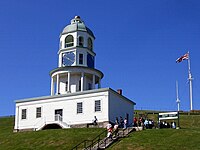
King George's War (1744–1748) is the name given to the military operations in North America that formed part of the War of the Austrian Succession (1740–1748). It was the third of the four French and Indian Wars. It took place primarily in the British provinces of New York, Massachusetts Bay, New Hampshire, and Nova Scotia. Its most significant action was an expedition organized by Massachusetts Governor William Shirley that besieged and ultimately captured the French fortress of Louisbourg, on Cape Breton Island in Nova Scotia, in 1745. In French, it is known as the Troisième Guerre Intercoloniale or Third Intercolonial War.

Acadia was a colony of New France in northeastern North America which included parts of what are now the Maritime provinces, the Gaspé Peninsula and Maine to the Kennebec River. During much of the 17th and early 18th centuries, Norridgewock on the Kennebec River and Castine at the end of the Penobscot River were the southernmost settlements of Acadia. The French government specified land bordering the Atlantic coast, roughly between the 40th and 46th parallels. It was eventually divided into British colonies. The population of Acadia included the various indigenous First Nations that comprised the Wabanaki Confederacy, the Acadian people and other French settlers.
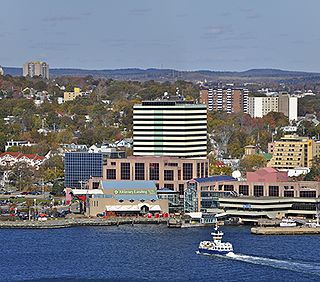
Dartmouth is a built-up community of Halifax Regional Municipality, Nova Scotia, Canada. Located on the eastern shore of Halifax Harbour, Dartmouth has 72,139 residents as of 2021.

Citadel Hill is a hill that is a National Historic Site in Halifax, Nova Scotia, Canada. Four fortifications have been constructed on Citadel Hill since the city was founded by the English in 1749, and were referred to as Fort George—but only the third fort was officially named Fort George. According to General Orders of October 20, 1798, it was named after King George III. The first two and the fourth and current fort, were officially called the Halifax Citadel. The last is a concrete star fort.

The Halifax Peninsula is a peninsula within the urban area of the Municipality of Halifax, Nova Scotia.

Edward Cornwallis was a British career military officer and was a member of the aristocratic Cornwallis family, who reached the rank of Lieutenant General. After Cornwallis fought in Scotland, putting down the Jacobite rebellion of 1745, he was appointed Groom of the Chamber for King George II. He was then made Governor of Nova Scotia (1749–1752), one of the colonies in North America, and assigned to establish the new town of Halifax, Nova Scotia. Later Cornwallis returned to London, where he was elected as MP for Westminster and married the niece of Robert Walpole, Great Britain's first Prime Minister. Cornwallis was next appointed as Governor of Gibraltar.
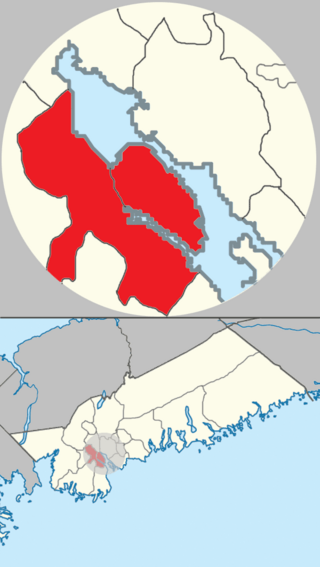
The community of Halifax, Nova Scotia was created on 1 April 1996, when the City of Dartmouth, the City of Halifax, the Town of Bedford, and the County of Halifax amalgamated and formed the Halifax Regional Municipality. The former City of Halifax was dissolved, and transformed into the Community of Halifax within the municipality.
West Lawrencetown is a residential community within the Halifax Regional Municipality Nova Scotia on the Eastern Shore on Route 207 along the scenic route Marine Drive.
Dartmouth founded in 1750, is a Metropolitan Area and former city in the Canadian province of Nova Scotia.

Lawrencetown is a Canadian rural community in the Halifax Regional Municipality in Nova Scotia, Canada. The settlement was established during the eve of Father Le Loutre's War and at the beginning of the French and Indian War.

Abbé Jean-Louis Le Loutre was a Catholic priest and missionary for the Paris Foreign Missions Society. Le Loutre became the leader of the French forces and the Acadian and Mi'kmaq militias during King George's War and Father Le Loutre's War in the eighteenth-century struggle for power between the French, Acadians, and Miꞌkmaq against the British over Acadia.
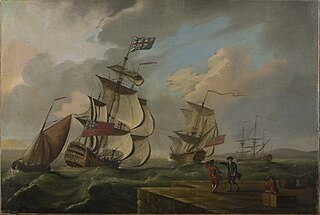
John Rous was a Royal Navy officer and privateer. He served during King George's War and the French and Indian War. Rous was also the senior naval officer on the Nova Scotia station during Father Le Loutre's War. Rous' daughter Mary married Richard Bulkeley and is buried in the Old Burying Ground in Halifax, Nova Scotia.
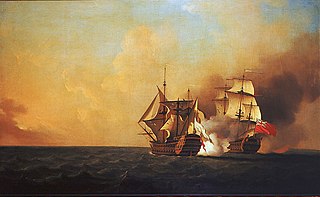
The Duc d'Anville expedition was sent from France to recapture Louisbourg and take peninsular Acadia. The expedition was the largest military force ever to set sail for the New World prior to the American Revolutionary War. This effort was the fourth and final French attempt to regain the Nova Scotian capital, Annapolis Royal, during King George's War. The Expedition was also supported on land by a force from Quebec under the command of Jean-Baptiste Nicolas Roch de Ramezay. Along with recapturing Acadia from the British, d'Anville was ordered to "consign Boston to flames, ravage New England and waste the British West Indies." News of the expedition spread fear throughout New York and New England.

The Raid on Dartmouth occurred during Father Le Loutre's War on May 13, 1751, when a Miꞌkmaq and Acadian militia from Chignecto, under the command of Acadian Joseph Broussard, raided Dartmouth, Nova Scotia, destroying the town and killing twenty British villagers and wounding British regulars. The town was protected by a blockhouse on Blockhouse Hill with William Clapham's Rangers and British regulars from the 45th Regiment of Foot. This raid was one of seven the Natives and Acadians would conduct against the town during the war.
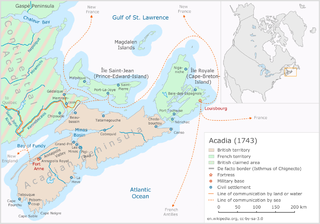
Father Le Loutre's War (1749–1755), also known as the Indian War, the Mi'kmaq War and the Anglo-Mi'kmaq War, took place between King George's War and the French and Indian War in Acadia and Nova Scotia. On one side of the conflict, the British and New England colonists were led by British officer Charles Lawrence and New England Ranger John Gorham. On the other side, Father Jean-Louis Le Loutre led the Mi'kmaq and the Acadia militia in guerrilla warfare against settlers and British forces. At the outbreak of the war there were an estimated 2500 Mi'kmaq and 12,000 Acadians in the region.

The Acadian Exodus happened during Father Le Loutre's War (1749–1755) and involved almost half of the total Acadian population of Nova Scotia deciding to relocate to French controlled territories. The three primary destinations were: the west side of the Mesagoueche River in the Chignecto region, Isle Saint-Jean and Île-Royale. The leader of the Exodus was Father Jean-Louis Le Loutre, whom the British gave the code name "Moses". Le Loutre acted in conjunction with Governor of New France Roland-Michel Barrin de La Galissonière who encouraged the Acadian migration. A prominent Acadian who transported Acadians to Ile St. Jean and Ile Royal was Joseph-Nicolas Gautier. The overall upheaval of the early 1750s in Nova Scotia was unprecedented. Present-day Atlantic Canada witnessed more population movements, more fortification construction, and more troop allocations than ever before in the region. The greatest immigration of the Acadians between 1749 and 1755 took place in 1750. Primarily due to natural disasters and British raids, the Exodus proved to be unsustainable when Acadians tried to develop communities in the French territories.

The Raid on Dartmouth (1749) occurred during Father Le Loutre's War on September 30, 1749 when a Mi'kmaw militia from Chignecto raided Major Ezekiel Gilman's sawmill at present-day Dartmouth, Nova Scotia, killing four workers and wounding two. This raid was one of seven the Wabanaki Confederacy and Acadians would conduct against the settlement during the war.

Nova Scotia is a Canadian province located in Canada's Maritimes. The region was initially occupied by Mi'kmaq. The colonial history of Nova Scotia includes the present-day Maritime Provinces and the northern part of Maine, all of which were at one time part of Nova Scotia. In 1763, Cape Breton Island and St. John's Island became part of Nova Scotia. In 1769, St. John's Island became a separate colony. Nova Scotia included present-day New Brunswick until that province was established in 1784. During the first 150 years of European settlement, the colony was primarily made up of Catholic Acadians, Maliseet, and Mi'kmaq. During the last 75 years of this time period, there were six colonial wars that took place in Nova Scotia. After agreeing to several peace treaties, the long period of warfare ended with the Halifax Treaties (1761) and two years later, when the British defeated the French in North America (1763). During those wars, the Acadians, Mi'kmaq and Maliseet from the region fought to protect the border of Acadia from New England. They fought the war on two fronts: the southern border of Acadia, which New France defined as the Kennebec River in southern Maine, and in Nova Scotia, which involved preventing New Englanders from taking the capital of Acadia, Port Royal and establishing themselves at Canso.
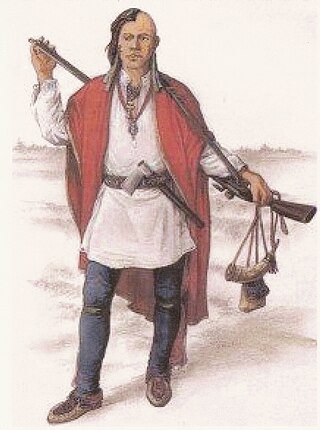
The military history of the Mi'kmaq consisted primarily of Mi'kmaq warriors (smáknisk) who participated in wars against the English independently as well as in coordination with the Acadian militia and French royal forces. The Mi'kmaq militias remained an effective force for over 75 years before the Halifax Treaties were signed (1760–1761). In the nineteenth century, the Mi'kmaq "boasted" that, in their contest with the British, the Mi'kmaq "killed more men than they lost". In 1753, Charles Morris stated that the Mi'kmaq have the advantage of "no settlement or place of abode, but wandering from place to place in unknown and, therefore, inaccessible woods, is so great that it has hitherto rendered all attempts to surprise them ineffectual". Leadership on both sides of the conflict employed standard colonial warfare, which included scalping non-combatants. After some engagements against the British during the American Revolutionary War, the militias were dormant throughout the nineteenth century, while the Mi'kmaq people used diplomatic efforts to have the local authorities honour the treaties. After confederation, Mi'kmaq warriors eventually joined Canada's war efforts in World War I and World War II. The most well-known colonial leaders of these militias were Chief (Sakamaw) Jean-Baptiste Cope and Chief Étienne Bâtard.

The military history of the Acadians consisted primarily of militias made up of Acadian settlers who participated in wars against the English in coordination with the Wabanaki Confederacy and French royal forces. A number of Acadians provided military intelligence, sanctuary, and logistical support to the various resistance movements against British rule in Acadia, while other Acadians remained neutral in the contest between the Franco–Wabanaki Confederacy forces and the British. The Acadian militias managed to maintain an effective resistance movement for more than 75 years and through six wars before their eventual demise. According to Acadian historian Maurice Basque, the story of Evangeline continues to influence historic accounts of the expulsion, emphasising Acadians who remained neutral and de-emphasising those who joined resistance movements. While Acadian militias were briefly active during the American Revolutionary War, the militias were dormant throughout the nineteenth century. After confederation, Acadians eventually joined the Canadian War efforts in World War I and World War II. The most well-known colonial leaders of these militias were Joseph Broussard and Joseph-Nicolas Gautier.
